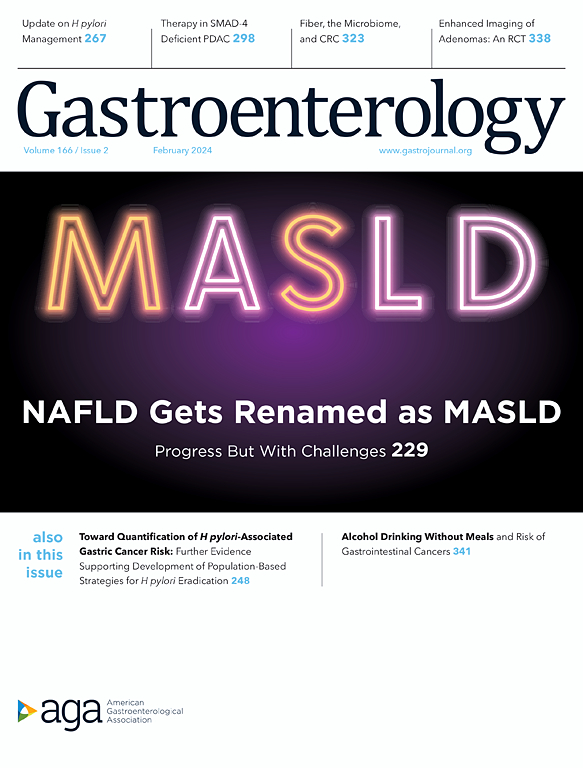Peyer’s patch B cells sample transglutaminase-gluten complexes and drive celiac disease autoimmunity
IF 25.7
1区 医学
Q1 GASTROENTEROLOGY & HEPATOLOGY
引用次数: 0
Abstract
Background and aims
The production of autoantibodies against the enzyme transglutaminase 2 (TG2) in celiac disease likely results from TG2-specific B cells receiving help from gluten-specific CD4+ T cells in gut-associated lymphoid tissues (GALT) via the formation of transient enzyme-substrate complexes formed between TG2 and gluten. Where in the body enzymatically active TG2 encounters gluten peptides remains unknown.Methods
A model to study the celiac disease-relevant T cell-B cell interactions in GALT has been developed. Mice expressing HLA-DQ2.5 received TG2-specific B cells and gluten-specific T cells by adoptive transfer and were subsequently orally immunized with a model antigen containing the the B-cell and T-cell epitopes.Results
Orally immunized HLA-DQ2.5 knock-in mice developed TG2-specific gut IgA and serum IgG responses. Activated TG2-specific B cells were present in Peyer’s patches and in gut-draining mesenteric lymph nodes, resembling what is seen in human celiac disease. We demonstrate that TG2-specific B cells in Peyer’s patches sample TG2 when the protein is perfused into the gut lumen.Conclusion
The model supports a mechanism where TG2-gluten complexes formed in the gut lumen are taken up by TG2-specific B cells in GALT. We propose that this pathway plays an important role in driving the anti-TG2 IgA autoantibody response in celiac disease patients. The model provides a platform to explore novel approaches for celiac disease therapies.

Peyer’s patch B细胞样品转谷氨酰胺酶-谷蛋白复合物和驱动乳糜泻自身免疫
背景和目的乳糜泻中针对谷氨酰胺转酶2 (TG2)的自身抗体的产生可能是由于TG2特异性B细胞接受肠道相关淋巴组织(GALT)中谷蛋白特异性CD4+ T细胞的帮助,通过在TG2和谷蛋白之间形成短暂的酶-底物复合物。在体内酶活性TG2遇到谷蛋白肽的位置仍然未知。方法建立模型,研究GALT中与乳糜泻相关的T - b细胞相互作用。表达HLA-DQ2.5的小鼠通过过继性转移接受tg2特异性B细胞和谷蛋白特异性T细胞,随后用含有B细胞和T细胞表位的模型抗原口服免疫。结果免疫HLA-DQ2.5敲入小鼠出现tg2特异性肠道IgA和血清IgG应答。活化的tg2特异性B细胞存在于Peyer 's斑块和肠引流肠系膜淋巴结中,类似于在人类乳糜泻中所见。我们证明,当TG2蛋白被灌注到肠腔中时,Peyer 's斑块中的TG2特异性B细胞会对TG2进行采样。结论该模型支持肠腔内形成的tg2 -谷蛋白复合物被GALT中tg2特异性B细胞吸收的机制。我们认为该途径在乳糜泻患者的抗tg2 IgA自身抗体反应中起重要作用。该模型为探索乳糜泻治疗新方法提供了一个平台。
本文章由计算机程序翻译,如有差异,请以英文原文为准。
求助全文
约1分钟内获得全文
求助全文
来源期刊

Gastroenterology
医学-胃肠肝病学
CiteScore
45.60
自引率
2.40%
发文量
4366
审稿时长
26 days
期刊介绍:
Gastroenterology is the most prominent journal in the field of gastrointestinal disease. It is the flagship journal of the American Gastroenterological Association and delivers authoritative coverage of clinical, translational, and basic studies of all aspects of the digestive system, including the liver and pancreas, as well as nutrition.
Some regular features of Gastroenterology include original research studies by leading authorities, comprehensive reviews and perspectives on important topics in adult and pediatric gastroenterology and hepatology. The journal also includes features such as editorials, correspondence, and commentaries, as well as special sections like "Mentoring, Education and Training Corner," "Diversity, Equity and Inclusion in GI," "Gastro Digest," "Gastro Curbside Consult," and "Gastro Grand Rounds."
Gastroenterology also provides digital media materials such as videos and "GI Rapid Reel" animations. It is abstracted and indexed in various databases including Scopus, Biological Abstracts, Current Contents, Embase, Nutrition Abstracts, Chemical Abstracts, Current Awareness in Biological Sciences, PubMed/Medline, and the Science Citation Index.
 求助内容:
求助内容: 应助结果提醒方式:
应助结果提醒方式:


